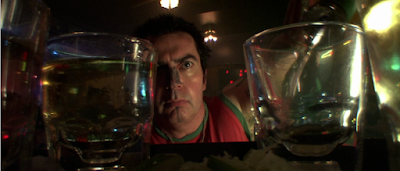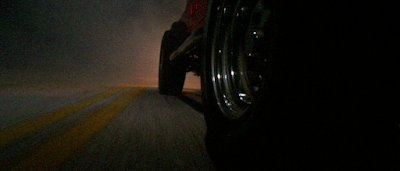On October 26, 2001, Chante Mallard, buzzing on a cocktail of marijuana, Ecstasy and alcohol, was driving home from a friend’s apartment after a hard night of clubbing in Fort Worth, Texas. Somewhere along the way, she struck a homeless man with her car, later identified as Gregory Biggs; and so great was the impact, Biggs’ body wound up punching through the front windshield where it got stuck.
But instead of calling the police or an ambulance, a panicked and stoned Mallard just drove on home, parked the vehicle in her garage, left Biggs, still alive, where he landed, impaled through the glass, and then, essentially, patiently waited for him to bleed to death.
Fort Worth Star-Telegram, April 26, 2002.
When Biggs finally died after an unknown amount of time (-- the coroner’s report estimated at least several hours after the initial impact), Mallard, a former nurse’s aide, contacted a friend, who helped her remove the body from the car and transported it to a nearby park, where it was abandoned. Upon returning home, Mallard set about destroying all the incriminating evidence, including burning parts of her car.
Several months would pass, and when no one linked her to the crime, in not the wisest of moves, Mallard began bragging and laughing about the incident -- until she blabbed in front of the wrong person, who passed this info along to the authorities.
Fort Worth Star-Telegram, June 27, 2003.
At trial, it came to light that if Biggs had been given prompt medical attention there was little doubt he could have survived his injuries. And so, in June of 2003, Mallard was convicted of murder and given a 50-year sentence plus ten more for tampering with evidence.
This gruesome hit-and-stuck case and the gross negligence by its perpetrator made national headlines and inspired all kinds of rumors and hearsay about how it took several days for the victim to die, or how Mallard had sex with her boyfriend while Biggs was slowly bleeding to death; or how Mallard had checked on the victim several times, who pitifully asked for help only to be callously ignored until he expired.
After the trial and conviction, this notorious incident would go on to inspire episodes for several small screen police procedurals -- CSI: Crime Scene Investigation (“Anatomy of a Lye,” Season 2, Episode 21) and Law & Order (“Darwinian,” Season 14, Episode 11). Then, in 2007, Stuart Gordon -- Re-Animator (1985), From Beyond (1986), brought the scenario to the big screen as a [jet] black comedy with Stuck (2007), which took a few dramatic liberties and added a few absurdist twists that resulted in one nasty little flick.
Two years later, first time director Enda McCallion’s Hit and Run (2009) mixed the Mallard case with the old urban legend where a black-out drunk driver thinks he’s hit a dog on the way home, sleeps it off, only to discover the following morning, to his horror, that it wasn’t a dog at all but an eight-year-old girl he'd hit because she was still lodged in the grill of his car!
Here, our tale begins with college student Mary Murdock (Breckenridge) being talked into one more round of shots before heading home for spring break. And so, a little tipsy, Mary fires up her Jeep and hits the road. Several dozen miles later, while tinkering with the radio, the driver rounds a curve and sees what’s left of a detonated semi-tire impeding the road and haphazardly swerves to miss it, resulting in a little impromptu and violent off-road action. Once she gets the vehicle back under control, back on the pavement, and stopped, Mary lets out a huge sigh of relief over this close call. After that, the rest of the journey home is pretty uneventful.
Parking in the darkened garage of her parent’s home (-- seems the bulb has burned out), Mary then follows some old sagely alcoholic’s advice by inducing some vomiting (– trust me, she’ll feel better in the morning). But after hitting the sack, Mary is soon awoken by some strange noises emanating from the garage. Noises that, if I’m lyin’ I’m dyin’, sound exactly like the Portsmith Sinfonia trying to pull off the theme to JAWS (1975). If this was intended as menacing or a comical homage is, well, up to each individual viewer.
Anyhoo, with flashlight in hand, Mary investigates only to discover a bloodied and mangled body stuck to the front of her Jeep! Obviously, she accidentally hit someone while running herself off the road without realizing it (-- more plausible than it sounds); and after a few quick pokes prove the man is still alive, Mary moves to help him.
But the gravely injured and delirious man starts flailing and angrily grabs for her, causing a frightened Mary to instinctively grab a nearby golf club, which she uses to defend herself and, in her panic, promptly beats the man to death.
From there, panic gives way and self-preservation takes over as Mary pries the man loose -- and one has to wonder if those giant improbable meat-hooks on the front bumper of her Jeep were part of an extended Mad Max package from the dealership? She then wraps the body up in a blanket before burying it in a shallow grave somewhere deep in the New Jersey woods.
The next day is mostly spent destroying evidence of the crime before Mary’s parents return home from a weekend trip. And as the day grinds on, Mary begins to slowly crack-up and starts self-medicating to keep it together: a combination of booze and pills.
On the local news, she discovers the man she hit was a beloved kindergarten teacher named Timothy Emser (Corrigan), whose wife, Jane (Anderson), says he just went for a late-night walk without his shoes or medication and pleads for his safe return. This revelation doesn’t help Mary’s fragile mental state, who confesses to her boyfriend, Rick (Shand), looking for some circumstantial absolution to ease her conscience.
Sticking with this callous theme, Rick is less concerned about his girlfriend actually killing someone and more concerned that she won’t have sex with him now because of it. And as Mary’s paranoia grows ever deeper, the girl realizes she buried the incriminating blanket with Emser and convinces Rick to meet at the grave site later to retrieve it.
But when Rick doesn’t show as promised, Mary works to exhume the corpse alone -- only to find Emser gone with Rick’s dead body left in his place!
Now, while this kind of tale could’ve led to an interesting character study on the motivations of why someone would react the way Mallard or Mary did, or any of us for that matter, to this dire set of circumstances and the strange, counter-intuitive compulsion to confess, Hit and Run is ... not that film.
However! What it is was a fairly effective thriller, especially when considering its first-effort status. The film is not concerned with the “why” but focuses solely on the “how” – and the bloodier the better, as things go completely bonkers after Emser proves to still be alive, who then trails Mary back to her house, where he torments her further with Rick's stolen cellphone.
And after several twists and turns, Emser eventually turns the tables on the girl, knocking her out and binding her to the front of the Jeep, and then takes Mary for a harrowing joyride, killing a gas station attendant along the way.
This road-trip then ends in Emser’s own garage, where he has a momentarily happy reunion with his relieved wife. But Emser won’t allow her to call an ambulance for him as she tries and fails to dress his multiple wounds. We also find out that those meds he hasn’t been taking for the past few days are for a bi-polar disorder.
It’s the Emser’s son who first finds Mary still bundled to the bumper, who alerts his mom. And while his wife tries to free the captive, Emser kills her with some pruning shears. He then takes Mary back to the burial site -- his tit-for-tat intentions clear, leading to a desperate fight for survival as we breach the climax.
Honestly, Hit and Run was a lot better than I ever thought it would be -- helped immensely by a third act that goes completely off the rails with some bizarre plot twists and contrivances that keeps the audience looking at the screen in amused, cock-eyed wonder. (Parrots? Really? Parrots. Hunh.) Also, the Christmas lights for bindings the killer keeps plugging in were a nice touch. And where in the hell did that blow-torch come from?
Behind the camera, McCallion, cinematographer Olivier Cocaul, and editor Miklos Wright did enough to garner MGM and 20th Century Fox’s attention, who packaged the film as part of a glut of ‘unrated’ direct-to-video, sweaty cleavage-fueled gore-fests.
In front of the camera, Laura Breckenridge is called on to carry the film as Mary until Kevin Corrigan takes over. Breckenridge isn’t quite up to the task -- close, but not quite. Corrigan, meanwhile, is absolutely terrifying as the unhinged Emser. Kudos to the make-up department for those mangled teeth, blown pupil, and butchered scalp that resulted in a truly terrifying visage that this film exploits brilliantly.
Look, there are no likable characters here -- only Emser’s wife garners any sympathy and look where that got her? But no one escapes unscathed in an ending that sort of works and ultimately satisfied with the narrative scales even.
And so, there it is, and here we are. And while I enjoyed Hit and Run for all the wrong reasons, odds are good your own viewing mileage may vary. Ah-lot.
Originally published on October 15, 2015 at Micro-Brewed Reviews.
Hit and Run (2009) Ithaka Entertainment :: Maverick Films :: Metro-Goldwyn-Mayer (MGM) :: 20th Century Fox Home Entertainment / EP: Guy Oseary, Benjamin Sitzer / P: Brent Emery, Mark Morgan, Braxton Pope, Scott Reed, Ron Singer, Andrew Weiner / D: Enda McCallion / W: Diane Doniol-Valcroze, Arthur Flam / C: Olivier Cocaul / E: Miklos Wright / M: Mateo Messina / S: Laura Breckenridge, Kevin Corrigan, Christopher Shand, Megan Anderson, Michael Gell






































%201982.jpg)


%201982_1.jpg)












.jpg)
_03.jpg)












%201982_2.jpg)


%201982.jpg)